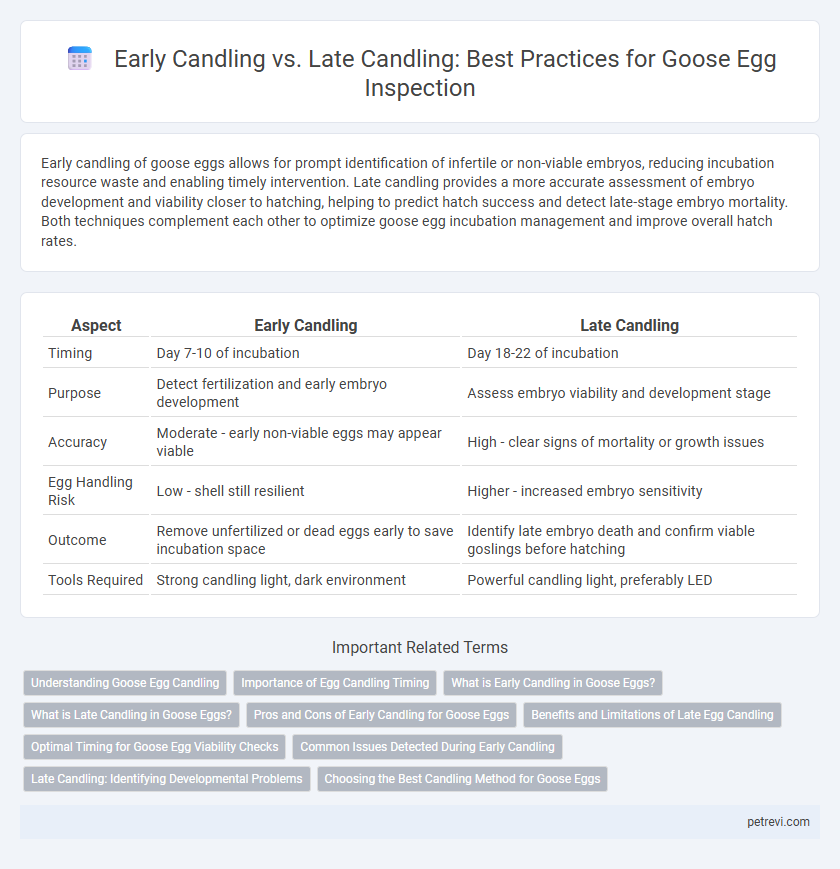Early candling of goose eggs allows for prompt identification of infertile or non-viable embryos, reducing incubation resource waste and enabling timely intervention. Late candling provides a more accurate assessment of embryo development and viability closer to hatching, helping to predict hatch success and detect late-stage embryo mortality. Both techniques complement each other to optimize goose egg incubation management and improve overall hatch rates.
Table of Comparison
| Aspect | Early Candling | Late Candling |
|---|---|---|
| Timing | Day 7-10 of incubation | Day 18-22 of incubation |
| Purpose | Detect fertilization and early embryo development | Assess embryo viability and development stage |
| Accuracy | Moderate - early non-viable eggs may appear viable | High - clear signs of mortality or growth issues |
| Egg Handling Risk | Low - shell still resilient | Higher - increased embryo sensitivity |
| Outcome | Remove unfertilized or dead eggs early to save incubation space | Identify late embryo death and confirm viable goslings before hatching |
| Tools Required | Strong candling light, dark environment | Powerful candling light, preferably LED |
Understanding Goose Egg Candling
Early candling of goose eggs, typically performed around day 7 to 10 of incubation, allows for the detection of fertilization and initial embryo development, enabling the removal of infertile or non-viable eggs to optimize hatch rates. Late candling, conducted after day 20, provides a clearer view of advanced embryo growth and allows for the identification of any dead embryos or abnormalities before hatching. Understanding the timing and findings of early versus late candling improves overall incubation management and increases the success rate of viable gosling production.
Importance of Egg Candling Timing
Early candling of goose eggs between days 7 and 14 of incubation allows for the detection of non-viable embryos and bacterial contamination, optimizing hatch rates by removing infertile or damaged eggs promptly. Late candling around day 25 enables assessment of embryo development and identification of issues like malposition or late mortality before hatching. Proper timing in egg candling maximizes incubation efficiency, improving overall hatchability and ensuring healthier gosling output.
What is Early Candling in Goose Eggs?
Early candling in goose eggs refers to the process of examining the eggs within the first 7 to 10 days of incubation to assess embryo development and viability. This technique involves shining a bright light through the eggshell to identify infertile eggs or those with dead embryos, which helps improve hatch rates by allowing timely removal. Early candling is essential for optimizing incubation management and ensuring successful goose egg production.
What is Late Candling in Goose Eggs?
Late candling in goose eggs refers to the process of examining the eggs after the initial stages of incubation, typically around day 21 to day 28 of the 28 to 35-day incubation period. This method helps identify the viability of the embryo by detecting late-stage development issues such as embryo death or malformations that were not visible during early candling. Late candling provides crucial information to optimize hatch rates and manage incubation conditions effectively.
Pros and Cons of Early Candling for Goose Eggs
Early candling of goose eggs, typically done around 7-10 days of incubation, allows for quicker identification of infertile or non-viable eggs, saving time and resources by removing them early. However, the embryo is still in a fragile developmental stage, making it harder to accurately assess viability compared to late candling. Early candling may also increase the risk of disturbing the eggs, potentially affecting hatch rates if not performed carefully.
Benefits and Limitations of Late Egg Candling
Late candling of goose eggs provides more accurate assessment of embryo development and viability, allowing identification of late-stage abnormalities and potential infertility. This method helps reduce resource waste by culling non-viable eggs closer to hatching, improving overall hatch rates and flock productivity. However, late candling risks disturbing delicate embryos and offers limited time for intervention compared to early candling, which detects problems at initial development stages.
Optimal Timing for Goose Egg Viability Checks
Early candling for goose egg viability checks is typically done between days 7 and 10 of incubation, allowing detection of early embryonic development and infertile eggs. Late candling, performed around days 24 to 28, helps confirm embryo survival and identify any late-stage non-viable eggs before hatching. Optimal timing balances early detection with minimizing disturbance to the developing gosling, ensuring better hatch rates and healthier outcomes.
Common Issues Detected During Early Candling
Early candling of goose eggs, typically performed between days 7 to 14 of incubation, is crucial for identifying common issues such as infertile eggs, early embryo death, and bacterial contamination. Detecting these problems early allows for the removal of non-viable eggs, reducing the risk of contamination and improving overall hatchability rates. Late candling, after day 21, focuses on assessing embryo development stages and identifying late-stage mortality, which are less impactful for managing incubation outcomes proactively.
Late Candling: Identifying Developmental Problems
Late candling of goose eggs, typically performed between days 18 to 25 of incubation, is crucial for identifying developmental problems such as embryo mortality, malformations, and improper growth. This technique allows more accurate detection of late-stage embryo viability issues that early candling may miss, ensuring better hatch rate management and resource allocation. Monitoring changes in blood vessel patterns and embryo movement during late candling provides essential insights into the health and progress of the developing gosling.
Choosing the Best Candling Method for Goose Eggs
Early candling for goose eggs typically occurs between 7 to 10 days of incubation, allowing for quick detection of infertile or non-developing embryos, which optimizes resource allocation and reduces contamination risks. Late candling, performed around 18 to 22 days, provides detailed insights into embryo development stages and viability, aiding in the identification of late-stage defects or mortality before hatching. Choosing the best candling method depends on specific breeding goals, with early candling favored for efficiency and late candling preferred for comprehensive embryo assessment.
Early candling vs Late candling for Goose egg checking Infographic

 petrevi.com
petrevi.com